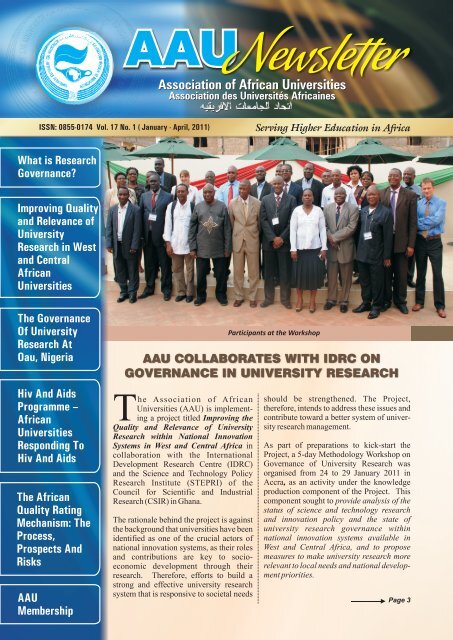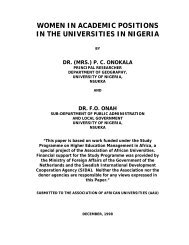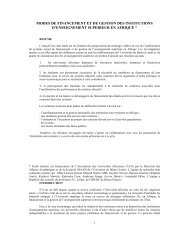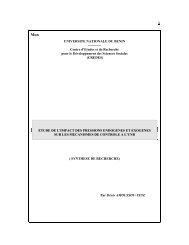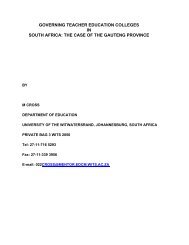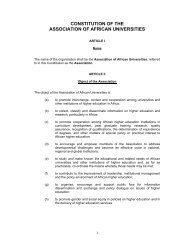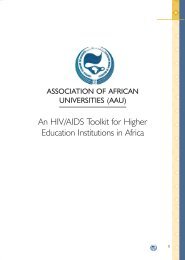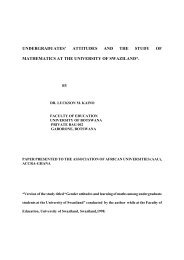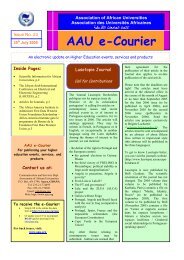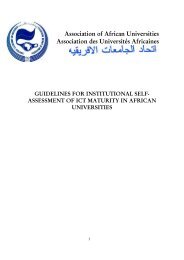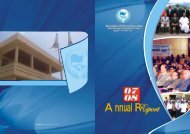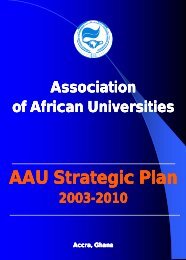AAU NEWSLETTER English Vol. 17 Issue 1 2011 - AAU Resource ...
AAU NEWSLETTER English Vol. 17 Issue 1 2011 - AAU Resource ...
AAU NEWSLETTER English Vol. 17 Issue 1 2011 - AAU Resource ...
- No tags were found...
You also want an ePaper? Increase the reach of your titles
YUMPU automatically turns print PDFs into web optimized ePapers that Google loves.
ISSN: 0855-0<strong>17</strong>4 <strong>Vol</strong>. <strong>17</strong> No. 1 ( January - April, <strong>2011</strong>)What is ResearchGovernance?Improving Qualityand Relevance ofUniversityResearch in Westand CentralAfricanUniversitiesThe GovernanceOf UniversityResearch AtOau, NigeriaHiv And AidsProgramme –AfricanUniversitiesResponding ToHiv And AidsThe AfricanQuality RatingMechanism: TheProcess,Prospects AndRisks<strong>AAU</strong>Membership<strong>AAU</strong> COLLABORATES WITH IDRC ONGOVERNANCE IN UNIVERSITY RESEARCHhe Association of AfricanUniversities (<strong>AAU</strong>) is implementinga project titled Improving the TQuality and Relevance of UniversityResearch within National InnovationSystems in West and Central Africa incollaboration with the InternationalDevelopment Research Centre (IDRC)and the Science and Technology PolicyResearch Institute (STEPRI) of theCouncil for Scientific and IndustrialResearch (CSIR) in Ghana.The rationale behind the project is againstthe background that universities have beenidentified as one of the crucial actors ofnational innovation systems, as their rolesand contributions are key to socioeconomicdevelopment through theirresearch. Therefore, efforts to build astrong and effective university researchsystem that is responsive to societal needsParticipants at the Workshopshould be strengthened. The Project,therefore, intends to address these issues andcontribute toward a better system of universityresearch management.As part of preparations to kick-start theProject, a 5-day Methodology Workshop onGovernance of University Research wasorganised from 24 to 29 January <strong>2011</strong> inAccra, as an activity under the knowledgeproduction component of the Project. Thiscomponent sought to provide analysis of thestatus of science and technology researchand innovation policy and the state ofuniversity research governance withinnational innovation systems available inWest and Central Africa, and to proposemeasures to make university research morerelevant to local needs and national developmentpriorities.Page 3
<strong>Vol</strong>. <strong>17</strong>, No. 1 (May, <strong>2011</strong>) <strong>AAU</strong> NewsletterPage 2PRESS RELEASETHE IMPORTANCE OFGOVERNANCEIN UNIVERSITY RESEARCHniversities play a vital role in the socio-economicdevelopment of nations through their three traditional rolesof training human resource, producing knowledge throughUresearch, and extension services to the society. The onset of aglobally competitive knowledge-driven economy has furtherunderscored the importance of universities and higher educationinstitutions in building national capacities to support social,economic, and political progress.Developed countries have registered much growth, becauseuniversities and higher education institutions have been in theforefront of the development process. Countries like South Korea,Singapore, Malaysia, and Thailand have experienced accelerateddevelopment due to increasing and sustained development of theirnational competences in developing and applying science,technology and innovations (STI) developed by universities andother knowledge institutions.For Africa to experience the growth of the South Asiancountries, research has to take the centre stage in higher educationinstitutions. Being the apex organisation and principal forum foraddressing issues of higher education in Africa, the Association ofAfrican Universities (<strong>AAU</strong>) is implementing a project on researchgovernance in West and Central Africa. The Project is beingexecuted in collaboration with the International DevelopmentResearch Centre (IDRC) and the Science and Technology PolicyResearch Institute (STEPRI) of the Council for Scientific andIndustrial Research (CSIR) in Ghana. The <strong>AAU</strong> is the strategicpartner in the research, because of its capacity to readily bringAfrican universities together to take part in the Project.In January this year, the <strong>AAU</strong> organised a 5-dayMethodology Workshop on Governance of University Research inAccra as an activity under the knowledge production component ofthe Project on Governance of University Research withinNational Innovation Systems (NIS) in West and Central Africa.This component seeks to provide analysis of the status of scienceand technology research and innovation policy and the state ofuniversity research governance within national innovation systemsavailable in West and Central Africa, and to propose measures tomake university research more relevant to local needs and nationaldevelopment priorities.This issue of the <strong>AAU</strong>'s Newsletter is mainly dedicated toarticles on governance of university research, including a casestudy of Obafemi Awolowo University at Ile Ife in Nigeria. The<strong>AAU</strong> continues to be committed to promoting quality assurance, aswell as responding to problems of HIV and AIDS in African highereducation. Articles on these programmes are also featured in theissue.The <strong>AAU</strong> will wishes to inform all its member institutions,partners and development partners that its Conference of Rectors,Vice Chancellors and Presidents of African Universities takesplace from May 30 to June 3 <strong>2011</strong> at the Spier Conference Centre,Stellenbosch, South Africa. The Conference which is beingorganised in collaboration with the Stellenbosch University has asits theme, Strengthening the Space of Higher Education in Africa.It is expected that about 250 delegates from African and other partsof the world will converge at Stellenbosch to discuss issuespertaining to the Implementing the Arusha Convention;Harmonisation of Degree Structures; Promoting QualityAssurance in Higher Education; Effectively Using Informationand Communication Technologies; Creating Regional Centres ofExcellence; and Promoting Open and Distance Learning – subthemeswhich fall under the general theme of the Conference.We will feature articles of the Conference proceedings in thenext issue of the <strong>AAU</strong> Newsletter.THE ASSOCIATION OF AFRICAN UNIVERSITIESORGANISES CONFERENCE OF RECTORS, VICECHANCELLORS AND PRESIDENT INSTELLENBOSCH, SOUTH AFRICAThe Association of African Universities (<strong>AAU</strong>) in collaborationwith Stellenbosch University, South Africa, will organise itsConference of Rectors, Vice Chancellors and Presidents of AfricanUniversities (COREVIP) from May 30 to June 3, <strong>2011</strong> inStellenbosch, South Africa at the Spier Conference Centre.The Conference of Rectors, Vice-Chancellors and Presidentsof African Universities (COREVIP) is an assembly of the chiefexecutive officers of member institutions or their representatives.It meets every two years with the purpose of examining collectivelythemes identified as common concerns and priorities for thedevelopment of higher education in member institutions; makingrecommendations primarily to members, as well as to theGoverning Board, and to the Secretariat; and acting as a mid-termforum for taking stock of the implementation of the decisions of theGeneral Conference and recommending corrective measures.The theme for the Conference is: Strengthening the Space ofHigher Education in Africa.There will be invited papers and presentations by distinguishedscholars and practitioners in plenary sessions as well as groupsessions for more intensive work dealing with the main theme andthe sub-themes, namely:Creating an African Higher Education Space: With focus onthe Arusha Convention; Establishment of AfriQAN; LMDReform in Francophone Higher Education Institutions;Establishment of a Credit Transfer System.The Role of ICT: With focus on the creation of Research andEducation Networks nationally and regionally: Promoting theuse of ICT in African higher education institutions.Regional Centres of Excellence: With focus on the AUC's PanAfrican University; Pan African Institute of Governance inHigher Education; Examples of other Centres of Excellence(AIMS in South Africa; 2IE in Burkina Faso; ICIPE in Kenya).Promoting Open and Distance Learning: With focus onOpen Educational <strong>Resource</strong>s; Creation of Open Universities;Use of Open Distance Learning (ODL) in traditionaluniversities.The Conference will provide an excellent opportunity for leaders ofAfrican higher education institutions to exchange experiences anddraw on the lessons from institutions on issues relating to the themeof the conference. There will also be an opportunity to hear fromboth regional and international organisations involved in highereducation initiatives.The 250 or more participants who are expected to attend theconference will comprise executive heads of <strong>AAU</strong> memberinstitutions, acclaimed African scholars, representatives of subregional,regional and international organisations, as well as donorand development agencies that partner with the <strong>AAU</strong>. In additionto the executive heads and other senior members of Africanuniversities, participants will include Ministers of HigherEducation and other policy makers.It is expected that the outcomes of this Conference willstrengthen the Space of Higher Education in Africa to assure qualityand equivalence in the delivery of higher educational servicesacross the continent, as well as sensitise the African highereducation community on the need for the ratification of the ArushaConvention by all African countries.Visithttp:// http://events.aau.org/eventapplication.php?id=15&/lang=en&mid=4/for more information on the <strong>AAU</strong> COREVIP <strong>2011</strong>
<strong>Vol</strong>. <strong>17</strong>, No. 1 (May, <strong>2011</strong>) <strong>AAU</strong> NewsletterPage 3The 24 participants who attended the Workshopincluded members of national research teams fromBurkina Faso, Cameroon, La Côte d'Ivoire, Ghana,and Senegal; resource persons and experts in therelated fields; and <strong>AAU</strong> staff.The Workshop was intended to provide the opportunityfor the national research teams to gain a better understandingof the Project and the various methods thatwould be used to undertake the study. It also provided aplatform to expose the country teams to the conceptualframework for the study and foster networking amongthe country teams. Specifically, the Workshop coveredareas such as Introduction to the Concept of theNational Innovation System, Analytical Frameworkfor the Analysis of National Innovation Systems, andThe Role of Universities in National InnovationSystems; and provided inputs to be included in the toolsof investigation (questionnaires, interview guide, etc.)and guidelines to map existing national innovationsystems to determine the role and place of universityresearch and interactions with other actors.BackgroundIn 2009, considering the increased interest in highereducation as a critical factor in development, the WestAfrica Regional Office of the Canadian IDRC commissioneda study on the state of university researchgovernance in West and Central Africa. After the study,a meeting was held in October 2009 to validate thefindings, which mainly showed a lack of appropriatestructures and noted deficiencies in research administration.Subsequently, in collaboration with the <strong>AAU</strong>and STEPRI of Ghana's CSIR, the IDRC developed aproject proposal to address these issues and contributetoward a better system of university research andmanagement.In March 2010, the IDRC approved the project onImproving the Quality and Relevance of UniversityResearch within National Innovation Systems inWest and Central Africa, which is being implementedby the <strong>AAU</strong> in partnership with Ghana Institute ofManagement and Public Administration (GIMPA),Centre d'Etudes Supérieures en Gestion (CESAG),STEPRI of Ghana's CSIR, West African Research andInnovation Management (WARIMA), and CanadianAssociation of University Research Administrators(CAURA).To keep the discussions on the Project ongoing, an e-platform was created to conduct discussion groups sothat participants could continue to interact with oneanother concerning the research methodologies andother technical issues after the Workshop.What is Research Governance?By Prof. Mazonda , University of Botswanahe main aim of university research governance is to createconducive environments and supportive policies andpractices to enable the university to be more responsive toTpublic expectations so that it may achieve the public good. It is alsomeant to spare the researchers the tedium of arranging complianceissues, which would compete with their research time.In Europe and the UK, higher education is at the centre of nationaldevelopment planning. The government uses universities as theengine of development. The universities serve as the vehicles forimplementing the national development plans. The government andthe universities collaborate closely.By contrast, the situation across much of Africa now is that there aregaps in linking university research with development priorities, aswell as weak linkages between knowledge producers and knowledgeusers, and between knowledge production and innovations. With thenew perception of universities as instruments for knowledge-basedeconomic development and change, universities are shifting fromconducting research merely for knowledge generation to researchthat addresses societal issues. In that sense, university research
<strong>Vol</strong>. <strong>17</strong>, No. 1 (May, <strong>2011</strong>) <strong>AAU</strong> NewsletterPage 4should be development-oriented and should seek topromote the public good.Research in a university:Helps the university improve teaching.Helps the quality of the curriculum andteaching at other levels of the educationalsystem.Helps the university fulfil its mission ofpublic service; that is, to play a critical rolewithin the NIS to improve national economicperformance and competitiveness throughhuman capacity building, leading to regionaleconomic development.Leads to spin-off companies that have becomea common feature in universities and areencouraging entrepreneurship. Universityspin-off companies help commercializeresearch results.How do we ensure that these happen?Important to put in place the structures,physical and systemwise, to encourage andfacilitate university research.Must develop the appropriate tools andcapacity to manage research as it becomesmore complex and diverse with a multiplicityof stakeholders; for example Medical School,Intellectual Property Office, and Office ofResearch Integrity.Must devise effective channels ofcommunication through which the widersociety is adequately consulted and its inputduly considered when setting researchpriorities and agendas.The university research governance has threecomponents:Organization of the research systemInstitutional steering of researchManagement of research structures andresourcesThe challenges in operationalising these threecomponents are as follows:A general trend in the lack of clear guidelinesfor organizing and managing universityresearch systems.Lack of guidelines for the accreditation ofresearch units.A proliferation of these units with limitedinteractions among them.Most universities have no mechanisms forsetting research agendas and priorities; so staffconduct disconnected individual research.Research processes are rarely evaluated,except for evaluations required by fundinginstitutions.The independent management of laboratoriesand research centres without commonguidelines weakens the system, and may leadto all kinds of uncontrollable deviations.Research at most universities competes withhigh teaching loads and external demands suchas consultancies and teaching at privateinstitutions. This leaves little time and energyto devote to doctoral students and research.Application of research results remains one ofthe major weaknesses because the linkageswith social demands and national developmentpriorities are rare if not non-existent.Improving Quality and Relevance of UniversityResearch in West and Central African UniversitiesBy Godfred FrempongScience and Technology Policy Research Institute (STEPRI) of Councilfor Scientific and Industrial Research (CSIR), Accra, GhanaIntroductionIt is now widely accepted that universities play a substantial role in thesocio-economic development of nations through their three traditional rolesof training human resource, producing knowledge through research, andextension services to the society. The arrival of a globally competitiveknowledge-driven economy has further underscored the importance ofuniversities and other knowledge institutions in building national capacities1to support social, economic, and political progress .1Frempong, G. K. (<strong>2011</strong>) Welcome Address at the Methodological Workshop for <strong>AAU</strong>/IDRC UniversityththResearch Governance Project held between 24 and 28 January at Airport West Hotel, Accra.
<strong>Vol</strong>. <strong>17</strong>, No. 1 (May, <strong>2011</strong>) <strong>AAU</strong> NewsletterPage 5The developed countries have registered much growth,because universities and other knowledge institutionshave been in the forefront of the development process.Countries like South Korea, Malaysia and Thailand hadsimilar economic situations like Ghana in the 1950s,but have experienced accelerated development due toincreasing and sustained development of their nationalcompetences in developing and applying science,technology and innovations (STI) developed byuniversities and other knowledge institutions.Research-based knowledge is now globally consideredto be a potent factor that enhances the socio-economicdevelopment of society. Consequently, there has beenmuch pressure on universities to deliver researchoutputs that respond to societal needs.The effectiveness of university research hinges on theexistence of an effective governance system thatprovides mechanisms for managing research andresources (human and material), ensuring high qualityand relevance of research, as well as engagement withknowledge users by the various university researchsystems. Consequently, there has been the need toreview and develop research governance policies tomake university research more responsive.IDRC/<strong>AAU</strong> University Research GovernanceProjectSeries of studies were commissioned in 2009 by theCanadian International Development Research Centre(IDRC) on university research governance in sixuniversities from five West and Central Africanuniversities: Université d’Abobo Adjamé (Côted’Ivoire), University of Buea (Cameroon), UniversitéCheikh Anta Diop and Université Gaston Berger(Senegal), University of Ghana, Legon (Ghana), andUniversité de Ouagadougou (Burkina Faso).The studies identified several gaps in structures foradministering, coordinating, and promoting research;the key ones being the following:• Gaps in linking university research withdevelopment priorities.• Weak linkages between knowledge producersand knowledge users.• Lack or seeming lack of interest in universityresearch by the political systems.• Lack of capacity for providing effectivedirection, organization and management of2university researchThese gaps always affect the ability of universities toconduct quality researches that are also relevant tonational development.The findings of these studies underscored the need forfurther rigorous analysis of the university researchgovernance system in West and Central Africa. Theproject has three key components: KnowledgeProduction, Institutional and Individual CapacityBuilding, and Multi-stakeholder Dialogue.ObjectivesThe main objective of the project is to strengthengovernance systems for research and foster betterlinkages between universities and other actors in thenational innovation systems to ensure qualityuniversity research and its relevance to local needs and3national development priorities . Besides, the otherobjectives are specific to each of the three areas of theproject. For Institutional and Individual CapacityBuilding, the objective is to contribute to theprofessionalization of the governance of universityresearch by developing and sharing tools and trainingmodules.With Multi-stakeholder Dialogue, it is to promotecontinuous dialogue and learning on the governance ofuniversity research through the development of acommunity of practice. Last but not least, KnowledgeProduction has the objective of generating pertinentknowledge on university research in West and CentralAfrica and making the knowledge generated availableto all stakeholders. These objectives will, invariably,contribute toward achieving the overarching aim of theproject.Activities of the ProjectSeveral activities have been identified under thevarious components of the project. KnowledgeProduction is basically a research on the universityresearch governance system. It will address the issueof national STI policies and university research, andmap existing national innovation systems to determinethe role and place of university research andinteractions with other actors. It will assess the existingmechanisms and practices on valorization anddissemination of research results in society, assess theconditions and practices that are necessary to buildsynergies between universities and end-users forsocio-economic development, and finally proposemeasures to integrate university research as a criticalpart of the national innovation system.Under Institutional and Individual Capacity Building,governance tools will, among others, address theResearch Strategic and Operational Plan, <strong>Resource</strong>Mobilization Plan, Administrative and FinancialProcedures Manual, and Code of Ethics. It will alsofocus on building capacities on science and technology2See <strong>AAU</strong> (2010) Improving The Quality And Relevance Of UniversityResearch Within National Innovation Systems In West And Central AfricaTheGovernance <strong>Issue</strong>s2See <strong>AAU</strong> (2010) Improving The Quality And Relevance Of UniversityResearch Within National Innovation Systems In West And CentralAfricaThe Governance <strong>Issue</strong>s
<strong>Vol</strong>. <strong>17</strong>, No. 1 (May, <strong>2011</strong>) <strong>AAU</strong> NewsletterPage 6policy research, provide opportunities for researchersto deepen their understanding and practice of STIpolicy research, and develop training modules onresearch management and administration.For the Multi-stakeholder Dialogue component, thekey activity is the annual forum involving vicechancellors of universities and key stakeholders. Theannual forum would provide a platform for discussinguniversity research and development, funding,priority setting and research planning, private-publicpartnerships and valorisation of research results. Otheractivities include collaborative e-Platform forCommunication and Knowledge Management andfield visits.Expected BenefitsHopefully, on completion, the project would havecontributed to improving university researchgovernance as well as making research responsive tothe needs of society. In addition, it is expected thatthere will be increased expertise in researchmanagement in universities and governance throughdevelopment of appropriate tools. Finally, the projectwill also result in better networking among researchmanagers and exposure to innovations and newapproaches in research management.THE GOVERNANCE OF UNIVERSITYRESEARCH AT OAU, NIGERIABy Prof. Biodun AdediranDirector, Linkages and Sponsored ResearchObafemi Awolowo University, Ile Ife, NigeriaPreambleResearch is the central function of an academicinstitution; it makes universities engines of communitydevelopment. It is the key defining factor of a universitythat distinguishes it from a college or polytechnic.Research is also crucial to the ranking of a universityas evidenced by the webometric ranking of worlduniversities. Furthermore, research enhances theprofile and image of a university as an academicinstitution. It also enhances the status of the institutionas an engine of community development by providinga basis for continual contribution to communitydevelopment as well as sound and effective teaching,which are two of the three mandates of a university.The Obafemi Awolowo UniversityThe Obafemi Awolowo University (OAU) wasestablished in the city of Ile Ife in Western Nigeria in1962. It is one of the leading universities in Nigeria,and is now owned by the Federal Government.Originally known as the University of Ife, it wasrenamed in 1987, after the demise of Chief ObafemiAwolowo, one of its founding fathers. The universitynow has teaching programmes in all major disciplines.It now has a student population of 30,000 undergraduatesand 5,000 students engaged in postgraduatestudies. The staff complement is made up of 1,372 fulltimeacademic staff and 1,662 senior administrativeand technical staff.InstitutionalS u p p o r t f o rResearchFrom its inception,researchhas been crucialto OAU. TheN a t i o n a lU n i v e r s i t i e sC o m m i s s i o n(NUC), whicha c c r e d i t suniversities inN i g e r i a , h a ssince the 1970s consistently ranked the university asNigeria's leading research university. This has beenconfirmed in recent years by the global webometricranking. The university's research engagement hasalways been emphasized in its vision and missionstatements. As stated in the University Edict in 1970,the mission of the institution is, 'to promote by researchand other means the advancement of knowledge and itspractical application to social, cultural, economic,scientific and technological problems.' This haspropelled the university to significant achievements,including the development of several new agriculturalcrops and new technologies geared toward local needs,pioneering kidney transplantation in Nigeria, separationof Siamese twins, competences in ICT, andcontinuous engagement in community service throughdedicated projects.The institutional support for research has been continuousas evidenced by the establishment of institutes,centres and units to facilitate research. In the 1990swhen there was a serious financial crisis, a Central
<strong>Vol</strong>. <strong>17</strong>, No. 1 (May, <strong>2011</strong>) <strong>AAU</strong> NewsletterPage 7Science Laboratory was established to ensurequalitative scientific research. There have also beenperiodic restructuring of the university researchmanagement framework as well as continuouscapacity-building initiatives for research, and foradministering research and sensitizationprogrammes for the university community. Majorstakeholders and funders from outside the universitycommunity are occasionally brought in to assess theuniversity's research engagements and overall impacton the society. The end story has been the provision ofguidelines for research contained in a comprehensiveResearch Policy Document approved by theUniversity Governing Council in 2007.The 2007 Research Policy (which is now underreview) emphasizes the need for a proactiveResearch Governance Structure to improve theresearch engagements of the university and enablemembers of staff to achieve some initiatives, including:• The conduct of strategic research that willincrease the postgraduate profile andenhance the university's research profile.• Improvement of research methodology andability.• Increased external funding of research.• Increased dissemination of research resultsthrough publication in key learned journalsand conference attendance.More importantly, the Research Policy Documentstrives to establish in the university a culture ofresponsible research by emphasizing several issuesthat individual researchers should bear in mind. Forinstance, it makes clear the obligations of theresearcher to the university, funding agency and thecommunity by bringing out the need for integrity inscholarship, financial stewardship, and good laboratoryand field practices. It also brings out the need forcollaboration in research, as well as adequatedissemination of research through exhibitions andpublishing in easily accessible format.The sensitization and capacity-building programmesare important for creating a culture of research andsustaining it in the university. They involve instillingin members of the community the rubrics of theacademic game, which basically involve teachingsome skills, namely:• Research methodology• Proposal writing• Research project design• Evaluation schedule/monitoring chart• Budget building• Monitoring and evaluation• Grants disbursement/execution• Dissemination of research results• Management of researchThe Research Governance StructureThe two central organs for research in the universityare the Central Office of Research (COR) and theDirectorate of Linkages and Sponsored Research(DLSR). The COR was established in the 1970s tocreate an enabling environment for research work inthe university. Originally, just a unit in the ViceChancellor's Office, it grew to become a major structurethat administers research and assists in the attemptto translate research into tangible developmentinterventions. The DLSR was created in 2003 tocomplement the COR and, in particular, take charge ofthe external research engagements of the university. Ithas projected and sustained the good image of theuniversity in the international academic arena.For the day-to-day administration of research, threelevels of committees are involved:• Departmental Research Committee• Faculty Research Committee• University Research CommitteeEach of the university's basic academic unit, department,has a committee for research. It is headed by theHead (Chair) of the department, and all members of theacademic staff compose the committee. The committee'sfunctions are to:• Carry out preliminary assessment of researchproposals by members of the department• Set research agenda/priority for the department• Advise faculty on the conduct/financing ofresearch• Consider reports on ongoing/completedresearch projectsThe Faculty Research Committee is chaired by a seniorprofessor in the faculty elected by the faculty board. Itis comprised of all departmental heads or chairs andone representative from each department. Its statutoryengagements are as follows:• Detailed assessment of research proposals• Ranking of research proposals within thefaculty• Advising the University Research Committee(URC) on the conduct and financing ofprojects• Considering annual progress and terminalreports from individual researchers• Making periodic reports to URC on research inthe facultyThe URC is a university-wide committee of Senatechaired by the Deputy Vice Chancellor (academic). It isthe body that promotes research in the university. TheCont. on page 10
<strong>Vol</strong>. <strong>17</strong>, No. 1 (May, <strong>2011</strong>) <strong>AAU</strong> NewsletterHIV AND AIDS PROGRAMME– AFRICAN UNIVERSITIES RESPONDING TO HIV AND AIDSParticipants at the WorkshopIntroductionAIDS has become one of the most devastating diseasesthe world has ever faced, posing serious challengesand undermining broad progress in development, aswell as in poverty reduction. Of the over 33 millionpeople worldwide estimated to be living with HIV in2008, sub-Saharan Africa accounted for 22.4 million(UNAIDS/WHO, 2009).In 2008, AIDS was the leading cause of death in sub-Saharan Africa. However, the scale and trends of theAIDS pandemic in the region vary considerably, withSouthern Africa being the most affected(UNAIDS/WHO, 2009). The core drivers of thepandemic disease have been placed under five broadheadings: (a) biological and physiological, (b) sexual,(c) socio-cultural, (d) economic, and (e) political. Thenumber of new infections in sub-Saharan Africa was15% lower in 2008 than 2001, translating into 400 000fewer infections in 2008.HIV and EducationThe effect of HIV and AIDS on the education sector iswell documented. It has been argued that the educationsector could be fortified to become a country'sstrongest weapon against HIV/AIDS; but if this fails,the sector would become the worst victim, reversingdecades of hard-won gains (The World Bank, 2002).In the higher education subsector, several universitiesin Africa are now responding to the pandemic by,among others, generating HIV/AIDS-related researchcovering all areas (scientific, medical, socioeconomicand communication) that has addedconsiderably to the international understanding of thedisease. To coordinate these efforts and scale up theefforts of universities to produce AIDS-competentgraduates, the Association of African Universities(<strong>AAU</strong>), in 2003, developed Phase I of amultidisciplinary HIV/AIDS Core Programme dubbed“African Universities Responding to HIV/AIDS.” Theprogramme aims to ensure that tertiary educationinstitutions in Africa continue to contribute towardproducing qualified, healthy, and productive graduatesfor the world of work in support of the continent'sdevelopment. In 2009, Phase II of the Programme wasdeveloped, which ends in 2013.The Phase II Programme has the followingcomponents:1. Strengthened top leadership of <strong>AAU</strong>member institutions2. Strengthened leadership and coordination of<strong>AAU</strong> Sub-Regional Networks3. Strengthened and improved university trainingand research on HIV and AIDS4. Strengthened HIV and AIDS prevention,treatment and care among <strong>AAU</strong> members5. Strengthened <strong>AAU</strong> Secretariat for improvedcoordinationStrengthened Leadership and Coordination of<strong>AAU</strong> Sub-Regional NetworksThe <strong>AAU</strong> HIV/AIDS establishment of the Sub-Regional Networks (SRNs) is also in line with theAssociation's resolve to devolve programmeimplementation to its members through sub-regionaland national groupings while the Secretariat plays amonitoring role.The <strong>AAU</strong> now has four sub-regional networks asfollows:
<strong>Vol</strong>. <strong>17</strong>, No. 1 (May, <strong>2011</strong>) <strong>AAU</strong> NewsletterPage 10Cont. from page 7THE GOVERNANCE OF UNIVERSITY RESEARCH AT OAU, NIGERIAfollowing compose the committee:• Six members of Senate elected by Senate• The University Librarian• The Provost, PG College• The Director, Central Science Laboratory• The University Bursar or Representative• The Director, Academic AffairsAs the research policy-making body in the university,the URC has, among its terms of reference, the following:• To advise the Senate on the development ofresearch in the university.• To coordinate all research activities in theuniversity, whether funded by the university orby outside grants.• To authorize applications for grants forresearch after they have been considered bythe Faculty Research Committee (FRC) andbefore such applications are submitted togranting agencies.• To administer the university research fundsand such other funds as are placed at thedisposal of the university for research.• To allocate, at its discretion, funds afterconsidering requests and recommendationsfrom the FRC.• To regularly review research procedures,regulations, etc.• To give periodic reports to Senate on researchwithin the university.In addition, the URC acts as an Ethical ReviewCommittee for the university. Thus, it carries outseveral crucial research-related functions, such as:• Monitoring compliance with the UniversityResearch Policy and Guidelines;• Providing independent and timely preview ofthe ethics of proposed studies;• Carrying out periodic reviews of projects;• Ensuring regular evaluation of the ethics ofongoing studies;• Providing quality control to ensure thatresults of research are credible; and• Encouraging publication in key journals andattendance at international conferences.The Administration of ResearchThe major concern of researchers at the onset is withfunds. The University Research Committee administersfunds for all internal projects. Applications forfunds are submitted on approved formats through thefaculty to the Central Office of Research, which vetsand passes them on to the URC. As its major functionis the administration of research project funds, theURC has criteria for assessing research proposalssubmitted for execution in the university and forallocating funds for research. These include theresearch focus of the proposal, the appropriateness ofthe methodology, profile of the research personnel,soundness of research plan, feasibility of the researchplan in terms of time frame, budget and resources, theexpected outcomes and anticipated benefits, ethicalstandards, and plan for disseminating research results.Once a research proposal is adjudged feasible andfundable, the URC proceeds to allocate funds for itsexecution, based on the availability of funds. Theprocedure is simple, straight- forward, and depends onthe annual allocation of funds to the university forresearch by the NUC. Once the URC allocates funds,the COR issues a letter of award and an agreement form.The agreement is endorsed by the Deputy ViceChancellor, while the Research Section of Bursaryadministers allocated funds.In performing its functions, the URC has had to come upwith several innovative strategies. To ensure that fundswent round as many researchers as possible, it came upwith the idea of giving priority to “mini researchp r o j e c t s ” b y b u d d i n g r e s e a r c h e r s , t e a mmultidisciplinary projects, and grants for postgraduateprojects. It also took several initiatives to ensure thatresearch was ongoing, in spite of scarce financialresources. These included:• Phasing of big projects over a long period• Providing supplementary grants to enablemeaningful completion of projects• Purchase of expensive equipment by the URCfor specific laboratories• Principle of 'spreading' of funds among allfacultiesTwo other units that play complementary roles inadministering research are the Learned ConferencesCommittee and the Grants and Agency Unit of theBursary. The Learned Conferences Committee encouragesattendance at conferences and supports theorganization of local conferences by making appropriatefinancial grants available to researchers. The Grantsand Agency Unit of the Bursary processes funds fromexternal grants.Ongoing Initiatives in Research GovernanceThe Directorate of Linkages and Sponsored Researchensures that the university keeps abreast of developmentsin the international academic arena.Consequently, the Directorate propels the university toembark on periodic stock-taking exercises and takestrategic steps that will improve linkages and researchgovernance. Along this line, several initiatives are nowbeing taken:• A proposal to overhaul the Central Office ofResearch to be headed by an ExecutiveDirector whose status will be equivalent to a
<strong>Vol</strong>. <strong>17</strong>, No. 1 (May, <strong>2011</strong>) <strong>AAU</strong> NewsletterPage 11Deputy Vice Chancellor. The new ResearchOffice will have four units, each to be headedby a Director of professorial rank. The units areResearch Administration, Linkages andPartnerships, Intellectual Property andTechnology Transfer, and GeneralAdministration. The proposal makes provisionfor the establishment of a University ResearchEthics Committee. In addition to aManagement Board to be chaired by the ViceChancellor, there will be four committees:University Research Committee, IntellectualProperty Committee, Linkages andPartnerships Committee, and Ethics ReviewCommittee.• On the drawing board is the establishment of aTechnology/Industrial Park. The blueprint forthe park is ready; adequate land has beenallocated for its take off, and discussions withthe private sector are at an advanced stage.• The university has instituted an annual researchfair to exhibit research products, engagements,and potentials of members of staff. This isregarded as an effective dissemination strategyto attract private developers and particularlyincrease partnership with industry for technicalsupport and student entrepreneurship.• As part of the regular curricular review exercise,the university in its <strong>2011</strong>-2015 StrategicPlan proposes to strengthen the extensionservice units, which are essentially the disseminationarms for research. These are the Centrefor Industrial Research and Development, theDrug Research and Production Unit, and theDepartment of Agricultural Extension andRural Development. For instance, there havebeen efforts in improving agricultural extensionactivities in the university. Ongoingprojects are concerned primarily with improvingagriculture by going beyond using conventionalteaching methods. Projects in homeeconomics, youth programmes, and ruralcommunity resource development seek toinfluence the behaviour of rural people througheducation and information exchange. The aimis to assist local communities in gaining alivelihood, improving the physical and psychologicallevel of living of rural families, andfostering rural community welfare. The successof the extension process basically rests on anatmosphere of mutual trust, helpfulness, andrespect on the part of extension workers and therural people.• Also in the Strategic Plan, the university willestablish Centres of Excellence to act asveritable centres of research in the followingareas:• Science and Technology Park (for theincubation of research findings)• Software Engineering• Cultural Studies• Sickle Cell Research• BiotechnologyThe background to this is the collaborationswhich the university has entered into with theprivate sector.• As a corollary to the preceding two initiatives,the university will embark on aggressive 'Townand Gown' activities to ensure that its researchengagements have direct impact on its immediatehost communities. Toward this end, since2007, OAU has acknowledged its symbioticrelationship with communities, and has soughtto build bridges among them. This has led to anincrease in the number of 'Town and Gown'partnerships with the goal of pooling resourcesin efforts to enhance service learning opportunitiesand engage in applied research. Effectivepartnerships generate numerous benefits toboth groups. The OAU partnerships with thetown have facilitated the enrichment ofacademic programmes by providing real-lifelearning opportunities, while communitieshave benefited by gaining access to informationsources and technologies that mightotherwise be unavailable to them.• Critical to the success of any project is informationdissemination. As the university's ICTinfrastructure improves, most information isdisseminated through electronic format andbrochures on different aspects of the university'sachievements and programmes. This hascontributed substantially to public awarenessof the research potentials of OAU. They havebeen useful in informing stakeholders of thenew thinking on the university's relations withthe outside world. With the proposed ExternalRelations Unit of the university, the image ofthe university will be further promoted throughincreased interactions with the media.• The Obafemi Awolowo University recognisesthe importance of institutionalising ResearchManagement, and efforts are ongoing to makeit a reality. Since 2009, a culture of researchmanagement has been embedded in theuniversity structures. A crop of researchadministrators is already being raised from theuniversity staff. They are being empoweredthrough various training and capacity-buildingworkshops. It is significant that the universityproposes to take the institutionalization ofResearch Management beyond its gates.Toward this end, OAU has packaged aD i p l o m a p r o g r a m m e i n R e s e a r c hAdministration. The programme will beavailable online to prospective ResearchAdministrators from the second half of <strong>2011</strong>.
<strong>Vol</strong>. <strong>17</strong>, No. 1 (May, <strong>2011</strong>) <strong>AAU</strong> NewsletterPage 12Cont. from page 9HIV AND AIDS PROGRAMMEunits; limited health facilities on campuses; limitedpsycho-social support for students affected andinfected; limited funding for HIV and AIDS research,especially in the natural sciences, clinical research andvaccines.Participants were taken through the types of methodsavailable for research. It came out clearly that thequalitative method was the best in HIV and AIDSresearch, as it helps one to observe behaviour andexplains why people behave the way they do.Participants were divided into working groups tobrainstorm on how to identify potential research areasand topics, and also the peculiar challenges.The Workshop was an opportunity for participants toshare experiences and be conversant with trends in HIVand AIDS in other institutions in the sub-region. Someparticipants were impressed with the way someinstitutions ran their clinics, where students and staffwere cared for and psychological support given whennecessary. Other participants lauded the good work ofthe <strong>AAU</strong> and recommended that a major workshop beorganised for countries in all the four sub-regionalnetworks to enable them share their experiences.THE AFRICAN QUALITY RATING MECHANISM:The Process, Prospects and RisksSummary of Keynote Address presented at Fourth International Conference on Quality Assurance andCapacity Building Training Workshop in AfricaBy Olusola Oyewole, African Union Commission, Addis-Ababa, Ethiopiahe African Union (AU) is committed to apeaceful, integrated and prosperous Africa.However, to achieve this vision, education is Tkey. Education promotes peaceful coexistence,creativity and innovation; and Africa urgently needs tobe committed to the training of highly qualified menand women to meet the challenges of today and thoseof the future.The AU identified higher education as an area of focusin the Plan of Action for the Second Decade of1Education for Africa (2006-2015) , with QualityAssurance as an area essential for revitalising highereducation in Africa. The Association of AfricanUniversities (<strong>AAU</strong>) also notes that Quality Assuranceissues are important for all African universities, seeingthat the quality of many African higher educationinstitutions has been adversely affected in recent yearsbecause of harsh economic, social, political, and even2conflict situations on the continent (<strong>AAU</strong>, 2004) .The African Quality Rating Mechanism (AQRM) is aninstrument of institutional self-assessment, based oncriteria peculiar to Africa and African institutions,1African Union (2006) Second Decade of Education for Africa(2006-2015). Plan of Action revised August 2006. COMEDAF 2+Meeting.2Association of African Universities (2004) Developing QualityAssurance Systems in African Universities. Accra: Association ofAfrican Universities.with the purpose of promoting the improvement of thequality of institutions in Africa. It is not a rankinginstrument, as it does not promote the listing ofinstitutions in a league table. However, it is supposedto help institutions to rate themselves on some qualitycriteria, as well as recognize their strengths. Theinstrument focuses on what quality means in thecontext of African higher education, and how qualitymight be measured or assessed.The African Higher Education Quality RatingMechanism has been developed as a tool that can beused for enhancing and ensuring quality in ourinstitutions and education systems. It will help toenhance the quality of African higher education andsupport the work of national, regional and continentalquality assurance bodies. It will also be instrumental inthe process of Harmonisation of Higher EducationProgrammes in Africa.The Process to the African Quality RatingMechanismThe research approach that has led to development ofthe AQRM for higher education programmes involvedthe following:• Desktop review on the Internet (World Wide Web)and a wide range of academic databases to:o identify key players in the fieldo determine the current trends and initiativeso identify issues on ranking and rating• Questionnaires were disseminated to some key
<strong>Vol</strong>. <strong>17</strong>, No. 1 (May, <strong>2011</strong>) <strong>AAU</strong> NewsletterPage 13stakeholders to understand perceptions and statusof ranking and rating, and to elicit input from keystakeholders on the value or otherwise of anAQRM for higher education.• Interviews were held with individuals to providefurther input to the focus.• Meeting of experts for discussion and criticalreview.• Discussion and brainstorming sessions by theSteering Committee of the Bureau of EducationMinisters.• Pilot project with 25 institutions.• Yearly exercise.The Context of the African Quality RatingMechanismIn developing the AQRM, efforts were made to developthe concept of higher education quality in an Africancontext. To do this, it became necessary to clarify anddefine some very important terms and issues that seemto have multiple understanding. These include thefollowing:• Higher EducationThe definition of higher education differs according tothe context in which it is used. However, all definitionsagree that higher education refers to post-secondaryeducation (or study beyond the level of post-secondaryeducation), in which a degree, diploma, or certificate isawarded at the end of study. This scope includes tertiaryeducation institutions other than universities and,therefore, covers universities, polytechnics andtechnical colleges, teacher training institutions,institutes for medical training and agriculture (andother fields), distance education centres, and researchcentres and institutes.• Quality of Higher EducationSeveral authors have noted that often terms in the areaof quality are vaguely defined and hence, open to3 4different interpretations (Ekong, 2003 ; Neave, 1994 ).Quality in higher education is a multi-dimensionalconcept, embracing all of its functions and activities:teaching and academic programmes, research andscholarship, staffing, students, buildings, facilities,equipment, services to the community, and theacademic environment; as well as by its internationaldimension: exchange of knowledge, interactivenetworking, mobility of teachers and students, andinternational research projects, while taking intoaccount national cultural values and circumstances.3Ekong, D. (2003). Quality: Trends from the UNESCO RegionalConsultations on Higher Education. Paper presented at theCommission II -Quality of Higher Education.4Neave, G. (1994) The Politics of Quality: Developments inHigher Education in Western Europe 1992-1994. EuropeanJournal of Education 29(2), 115-134.• Quality Assurance5Martin & Stella (2007) note that Quality Assurance(QA) is ‘a generic term used as shorthand for all formsof external quality monitoring, evaluation or reviewand may be defined as a process of establishingstakeholder confidence that provision (inputs,processes and outcomes) fulfils expectations ormeasures up to the minimum requirements.’ As ageneric term, QA can mean different things in differentnational and regional contexts, and is also used todenote different practices.The International Network of Quality AssuranceAgencies in Higher Education (INQAAHE) provides ageneric operational definition which encompassesmany different models of QA, and states that, “QualityAssurance is all of those attitudes, objects, actions, andprocedures, which through their existence and use, andtogether with the quality control activities, ensure thatappropriate academic standards are being maintainedand enhanced in each programme.” UNESCO alsodefines Quality Assurance as the systematic review ofeducational programmes to ensure that acceptablestandards of education, scholarship, and infrastructure6are being maintained (UNESCO, 2005) .• Internal and External Quality AssuranceInternal self-evaluation and external review, conductedopenly by independent specialists, if possible withinternational expertise, are vital for enhancing quality.7Martin & Stella (2007) distinguish between internaland external quality assurance as follows: While theformer refers to the policies and mechanismsimplemented in an institution or programme to ensurethat it is fulfilling its own purposes and meeting thestandards that apply to higher education in general or tothe profession or discipline in particular, the latterfocuses on the actions of an external body, which maybe a quality assurance agency or body other than theinstitution that assesses its operation or that of itsprogrammes, in order to determine whether it ismeeting the agreed or predetermined standards.RankingIn the higher education context, the term ranking isused to refer to the rating and ordering of higher5Martin, M. & Stella, A. (2007) External Quality Assurance inHigher Education: Making Choices (85). Paris: UNESCO:International Institute for Educational Planning. Pg. 34.6UNESCO (2005) Quality Assurance. Retrieved, from theWorldwide Web: Retrieved January 8, 2007 from UNESCOwebsite:http://portal.unesco.org/education/en/ev.php-RL_ID=41040&URL_DO=DO_TOPIC&URL_SECTION=201.html7Martin, M. & Stella, A. (2007) External Quality Assurance inHigher Education: Making Choices (85). Paris: UNESCO:International Institute for Educational Planning. Pg. 34.
<strong>Vol</strong>. <strong>17</strong>, No. 1 (May, <strong>2011</strong>) <strong>AAU</strong> NewsletterPage 14education institutions or programmes of study, based8on various criteria (Harvey, 2004) . All rankingsystems operate by comparing institutions against arange of indicators, while different ranking systemsuse very different indicators to obtain a picture of‘quality.’ The number of indicators in a ranking systemcan vary significantly from five to several dozens9(Usher & Savino, 2006) .Limitations of Global RankingIt has been generally noted that ranking has come tostay. While national ranking programmes, such as theNigerian universities’ ranking system, have helped topromote quality improvement, the same cannot be saidof the global ranking programmes. Various criticismshave been levelled at global ranking, especially itsunfavourable disposition to African institutions. Themajor criticisms of ranking include:• Heavy weighting toward the sciences:Weightings assigned to laboratory disciplinesare usually more than the other disciplines.Also, universities with medical schools andstrengths in the hard sciences generally have asignificant advantage, because these fieldsgenerate more external funding; andresearchers in these fields publish morearticles. Education analysts are increasinglyquestioning the validity and relevance of themost popular rankings, and various groups arenow devising alternative methods to assessingand improving the quality of institutions.Quality Enhancement in the African ContextAs global ranking systems favour certain types ofuniversities and certain aspects of higher education(e.g. science and research), due in part to differences indefining and thus ‘measuring’ what quality is, the fearis that if Africa continues to support the developmentof the global ranking systems in the way it is beingdone now, it could lead to higher education institutionsmodifying their missions and focus areas to maximizeranking performances. This will narrow diversity andprobably significantly reduce the range and depth ofthe benefits provided by higher education; it has thepotential to reduce the scope for innovations instrategy, curriculum, pedagogy, and research.Considering the limitations of global ranking toAfrican institutions, the need has been to developmechanisms to enhance the quality of institutions inAfrica without resorting to league tables.8Harvey, L. (2004) Analytic Quality Glossary. Quality ResearchInternational. Retrieved April 5, 2007, from the Worldwide Web:http://www.qualityresearchinternational.com/glossary/ranking9Usher, A. & Savino, M. (2006) A World of Difference: AGlobal Survey of University League Tables. Toronto:Educational Policy Institute.It was noted from a survey that such a mechanismshould provide an opportunity for institutions to strivetoward and invest more in quality, and to assess theirown capacity and quality, as this would promote the‘emergence of an institutional culture of accountabilityof the system to learners and society in general in termsof what one can expect of a ‘good university.’ It wouldalso ‘draw attention to areas of weakness in the systemand would help institutions in Africa to strive forexcellence’ and ‘promote public confidence that thequality of teaching and research is being safeguardedand enhanced.’ It is regarded as also having a potentialimpact on governments in that they ‘would be moresympathetic to institutional requests for qualityimprovement funding’ and would assist in identifyingand developing Centres of Excellence. For thesereasons, it is proposed that a Developmental AfricanHigher Education Quality Rating Mechanism becreated. This should be specifically driven by a qualityimprovement agenda in the first instance, withaccountability elements being included as these remainimportant, but are not the driving force. The ratingmechanism will allow for classification of institutionsand programmes into three categories: ‘unsatisfactoryquality’, ‘satisfactory quality’, and ‘excellent quality’.A quality rating rubric has been developed, with anexample for each criterion of what it means to be ratedat each of the three levels. Thus, institutions orprogrammes will be able to focus specifically on whatneeds to be done to improve quality. Institutions orprogrammes will not be compared, and there will be nodifferentiation between the institutions rated withineach category.The Rating MechanismRating is assessing performance based on a set ofgrades. Unlike ranking, in which all candidates forassessment are assumed to be the same, rating is onlyapplied to candidates belonging to the same category.In applying rating to higher education, institutions arecategorized (universities, polytechnics, monotechnics,broad-based, specialized, etc.) and later rated withintheir own categories. While ranking is an absolutemeasure that lists the first to last in any given field,rating sets out to categorize a broad range of qualities.Rating indicates the overall strengths of an institutionand identifies institutions with similar standing in eachof the categories rated.Major features of the African Quality RatingMechanism:• A blend of ‘fitness for purpose’ and‘excellence’ approaches to quality.• Takes institutional diversity into account.• Uses a series of quality criteria, but takesinstitutional context into account.• Seeks to build in opportunity for institutionalself-evaluation and reflection.• Makes no comparison with other institutions.
<strong>Vol</strong>. <strong>17</strong>, No. 1 (May, <strong>2011</strong>) <strong>AAU</strong> NewsletterPage 15• Rates quality as ‘unsatisfactory,’ ‘satisfactory,’or ‘excellent’ for the individual and overallcriteria.• Helps institutions to know what steps to takefor improvement.• Helps institutions to recognize their strengthsand weaknesses.In the AQRM, a series of quality criteria are proposedand assessed within the context of specific institutionalmissions. When submitting institutional andprogramme information, each institution will berequired to identify their specific focus area. Theinstitutional focus or mission is used to weight thecriteria for that specific institution. For example, whenan institution is positioned first as a teaching andlearning institution, criteria in this category will beweighted more highly than criteria in the researchcategory. This approach allows for an integration of‘fitness for purpose’ and ‘excellence’ approaches. Inline with current developments in external qualityassurance, participating in the quality ratingmechanism will be voluntary. Most voluntary systemsusually have various motivations for being qualityassured. Marketing of the quality rating mechanism andintegration of the mechanism into national and regionalquality assurance procedures will be important toencourage participation.Level of AnalysisWhile quality can be assessed at various units ofanalysis (programme, department, faculty, andinstitution), the African Quality Rating Mechanismwill focus on an institutional and programme level ofanalysis.In applying the African Higher Education QualityRating Mechanism, the first level of analysis will be theinstitution. Once institutions are thought to be of anacceptable level of quality, they will be invited tosubmit programme level data by which a quality ratingof specific programmes will be assigned. Taking theinstitution as the first point of analysis seeks to ensurethat the quality rating process also helps institutions todevelop internal quality assurance procedures that,over time, will lead to the development of a culture ofquality across African institutions. Thus, the qualityrating mechanism supports the development ofsustainable and comprehensive institutional levelquality assurance policy and procedures.The aim is to get institutions to take ownership of theirown quality assurance processes, in line with policyand procedures of national and regional qualityassurance bodies, and use the quality rating mechanismas one means of supporting continuous qualityimprovements. Institutions and programmes thatmaintain an ‘Excellent’ quality rating for at least 4 yearswill be considered for recognition as ‘AU Centres ofExcellence’.Approach to Criteria SelectionThe criteria included in the quality rating mechanismhave sought to include a range of input, process andoutput indicators and a variety of different types ofcriteria and standards. The criteria have been selectedand formulated (with good descriptions of each qualitylevel rating) with the specific intent of encouraginginstitutional self-reflection on quality issues, sosupporting the development of internal qualityassurance policies and procedures. The ratingmechanism provides a means of external validation ofthese internal processes. Criteria dealing with QualityAssurance specifically have been integrated into allcategories of criteria. Thus, the rating mechanismseeks to reinforce the importance of quality beingintegrated within the standard functioning of theinstitution, rather than as an add-on.The Institutional-level Criteria cover the followingcategories:• Governance and Management• Infrastructure• Finance• Teaching and Learning• Research, Publications and Innovation• Community and Societal EngagementsThe Programme-level Criteria cover the followingcategories:• Programme Planning and Management• Curriculum Development• Teaching and Learning• Assessment• Programme resultsRating Institutional QualityFor each specific criterion, there are three possiblescores: Unsatisfactory performance = 1, Satisfactoryperformance = 2, and Excellent performance = 3. Thequality rating mechanism takes the form of a rubric;hence, for each level of performance for each criterion,a description is provided detailing what performance atthat level means. Based on the information andevidence submitted by an institution, a score (1, 2 or 3)will be assigned to each criterion. These scores areautomatically summed to provide a subtotal for eachcategory of criteria, such as governance andmanagement, infrastructure, finances, and so on.The quality rating mechanism should be based on abalance between quality defined as ‘fitness forpurpose’ and quality defined as ‘excellence.’ The focuson ‘fitness for purpose’ specifically takes account ofthe diversity of institutions with different visions,missions and focuses. For example, it is likely thatsome institutions will focus largely on Teaching and
<strong>Vol</strong>. <strong>17</strong>, No. 1 (May, <strong>2011</strong>) <strong>AAU</strong> NewsletterPage 16Learning, others on Research, others might seek toprovide services particularly relevant to their localcommunity, while still others might provide acombination of each. Therefore, it is necessary tofactor in a weighting mechanism to take account ofinstitutional diversity. It has been assumed thatirrespective of institutional focus, quality criteria inthe areas of governance and management,infrastructure and finances are essentially applicableacross diverse institutions. Thus, these criteria do notneed to be weighted to take account of institutionalspecificities.Rating Programme QualityThe programme quality rating worksheet functions inthe same manner as the institutional quality ratingworksheet. For each specific criterion, there are threepossible scores: Unsatisfactory performance = 1,Satisfactory performance = 2, and Excellentperformance = 3. For institutional rating, a detailedformat with descriptions of performance at each levelis provided. The focus of the programme level criteriais on determinants of quality that are applicable acrossprogrammes, rather than on specific types ofprogrammes. Therefore, it is unnecessary to weightcriteria to take account of diversity acrossprogrammes. Once scores have been assigned to eachcriterion, subtotals per category of criteria areprovided and a programme level total score iscomputed.The RisksThe African Quality Rating Mechanism holds muchprospect for improving the quality of higher educationin Africa. However, some potential risks that need tobe considered to advance the laudable programmeinclude the following:1. SustainabilityThe AQRM is an initiative of the African Union (AU).Although the AU is well placed in policy initiatives,the organisation lacks the capacity to sustain theexecution of some of its policies over a prolongedperiod, as may be required of the AQRM. One of themajor risks that need to be addressed is that of thesustainability of the initiative. This risk can beovercome with a continental organisation that has thecredibility and track record to advance the laudableinitiative of the AU.2. Transparency and IntegrityCan the process remain transparent and conductedwith integrity? The buy-in depends on the integrity ofits execution.3. Conflicts with Regional Quality AssuranceFrame ProtocolEfforts at promoting regional quality assuranceprotocols in East and Southern Africa have made itnecessary for their institutions to respond to similarrequests for data and information on them. Theseinstitutions may be fatigued at the extra demands thatthe AQRM may make on them. However, it can beovercome by adequate publicity and dialogue with thevarious institutions.4. Minimum Benchmark for the CriteriaOne major limitation of the current instrument is theabsence of a benchmark of quality on each of thecriteria on which institutions can assess themselves.5. Limited Rating RangeThe current instrument has a scoring range of 1 to 3.Some experts have noted that a five-point scoringsystem might be more appropriate than the proposedthree-point scoring system. However, some noted that afive-point scale will move the mechanism to a level ofdetail that potentially makes implementation at acontinental level too complex, because it will becomeincreasingly difficult to provide such detail for a fivepointscale and distinguishing between four or fivepoints. It will be necessary to improve the scoringbeyond the three-point scoring, as the stakeholdersmay demand.6. Language ChallengesThe language diversity in Africa today is a majorchallenge to the mechanism. To be comprehensive, themechanism will need to be operated in <strong>English</strong>, French,Portuguese and Arabic. Unfortunately, this will makehigher demands on the operational cost of the process.7. FundingThe African Quality Rating Mechanism is now beingfunded with funds provided by member states of theAfrican Union. Unfortunately, there is no commitmenton how long the funding will be sustained. To sustainthe mechanism, the need is to secure a long-termfunding for the programme.8. Validation MechanismsAs it is for similar externally run quality assurancetools, the need will arise for a mechanism to validatethe claims of the various institutional respondents.Funding and modalities of the validation mechanismare yet to be finalized to build the necessarycreditability into the whole process.ConclusionThe African Quality Rating Mechanism is one of theefforts by Africa’s continental organization aimed atpromoting quality in African higher education. There issurely room and need for continuous improvement ofthe mechanism and its process. However, the first stepoffers hope that with the support of the African Union,the excellence in our various institutions would beidentified and promoted to develop our continent.
<strong>Vol</strong>. <strong>17</strong>, No. 1 (May, <strong>2011</strong>) <strong>AAU</strong> NewsletterPage <strong>17</strong><strong>AAU</strong> MEMBERSHIPThe <strong>AAU</strong> Newsletter is introducing theMEMBERSHIP PAGE. This and subsequent issues ofthe Newsletter will feature new members that haverecently joined the Association. The initiative is aimedat creating space for other member universities andtheir constituents (students, faculties, departments,etc.) to identify with new members to create networksand other collaborations.Membership of the <strong>AAU</strong> is open to universities inAfrica and institutions of higher education in Africathat have university status in their respective countries.For more information on membership, please visit.http://www.aau.org/sites/default/files/english/documents/aau_constitution2010.pdfAt the 68th meeting of the <strong>AAU</strong> Governing Board,which was held in Elmina, Ghana in June 2010, sevenuniversities were admitted to full membership status,bringing the number of members of the Association to259 as of January <strong>2011</strong>. The newly admitted membersat the time were as follows:• All Nations University College, Ghana• Benadir University, Somalia• Cavendish University, Zambia• Crawford University, Nigeria• East Africa University, Somalia• Hawassa University, Ethiopia• Puntland State University, SomaliaName of Institution: All Nations University College(ANUC), KoforiduaCountry: GhanaYear of Establishment: November 2002Status: Private UniversityWebsite: http://www.allnationsuniversity.orgHead of Institution: President - Dr Samuel Donkorhe vision of All Nations University College is toprovide quality education pursued in a ChristianTenvironment of truth and integrity. TheCollege's mission statements seek to provide qualityhigher education that promotes development and toraise leaders with Christian values and ethics for goodgovernance to serve the people. In promoting excellence,ANUC programmes are designed to enableindividuals to transfer theory into practice towardtechnological, social, cultural and economic development.All Nations University College now runs the followingprogrammes:Undergraduate Programmes:BE Oil & Gas Engineering; BE Electronics andCommunication Engineering; BE BiomedicalEngineering (full time & weekend); BE ComputerEngineering; BSc (Hons) Computer Science; BBABusiness Administration; BA Biblical Studies.Diploma Programme:Diploma in Biblical Studies CertificateProgrammes: Certificate in Biblical Studies;Certificate in Information CommunicationTechnology (ICT).All Nations University College has the followingdepartments: Department of Biomedical Engineering;Department of Electronics & CommunicationEngineering; Department of Oil & Gas Engineering;Department of Computer Science & Engineering;Department of Business Administration; Departmentof Biblical Studies; Department of Humanities &Social Sciences.Further enquiries about its library holdings, tuitionfees, requirements for admission to its programmesand for the award of degrees can be sought from theRegistrar: lynn.kisembe@allnationsuniversity.orgName of Institution: Benadir University, MogadishuCountry: SomaliaYear of Establishment: October 2002Status: Public UniversityWebsite: http://www.benadiruniversity.netHead of Institution: President - Dr MohammedMoallim Muse MDs a result of Somali's civil war, many qualifiedSomali doctors had either become victims ofAthe war or fled from the country in search ofbetter livelihood and security. Owing to the shortage, agroup of Somali doctors, after thorough analysis of thesituation, decided to reverse it and established BenadirUniversity in October 2002. The university startedwith a single faculty, the Faculty of Medicine.However, from an innovative and strategic vision ofthe university, other important disciplines were added,and Benadir University now has four faculties withover 500 students.The programmes of the university are designed todevelop the personality of the students and preparethem to play meaningful roles in developing the
<strong>Vol</strong>. <strong>17</strong>, No. 1 (May, <strong>2011</strong>) <strong>AAU</strong> NewsletterPage 18country. Benadir University strives to establish anopen system of innovation and critical thinking similarto what pertains in developed countries.Further enquiries about its library holdings, tuitionfees, requirements for admission to its programmesand for the award of degrees can be sought from thePresident: benadiruniversity@yahoo.com,drbidaymm@yahoo.comLeadership; MA Public Relations; MSc Project Mgmt;MA NGO/CSO Management; PGD in ManagementStudies. It also has four faculties: Faculty of Businessand Management, Faculty of Law, Faculty of SocialSciences, and ICT Faculty.Further enquiries about its library holdings, tuitionfees, requirements for admission to its programmesand for the award of degrees can be sought from theSales and Marketing Manager, Cavendish University:mwichens@gmail.comName of Institution: Cavendish University, LusakaCountry: ZambiaYear of Establishment: 2004Status: Private UniversityWebsite: http//: www.cavendishza.orgHead of Institution: Vice Chancellor - Mr K. M.SalatiName of Institution: Crawford UniversityCountry: NigeriaYear of Establishment: 2005Status: Private UniversityWebsite: http://www.crawforduniversity.edu.ngHead of Institution: Vice Chancellor - Professor M.T. Igehe vision of Cavendish University is to be theleading quality provider of business andmanagement university education and Ttraining in Central and Southern Africa. Its mission isto provide high quality tertiary education and trainingto enhance human and ecological livelihoods forsustainable development.Cavendish University now runs the followingprogrammes:Certificate Courses:Certificate in Information Technology (CIT);International Business and Management Certificate(IBMC); International Business and ManagementDiploma (IBMD).Diploma Courses:Diploma in Project Management (DPOM);Communications Diploma (MC Dip).Undergraduate Programmes:Bachelor of Business Administration (BBA):Bachelor of Arts NGO Management (BA NGO);Bachelor of Arts Public Relations (BA PR); Bachelorof Laws Degree (LLB); Bachelor of Arts Banking &Finance/Insurance (BA BF/Ins); Bachelor of Sciencein Computing (BSc Comp); Bachelor of ArtsEconomics (BA Econ).Postgraduate Diploma: PGD in ProjectManagement ; PGD in Monitoring and Evaluation.Masters Programmes:MBA Generic; Master of Law (LLM); MBA Finance ;MBA Human <strong>Resource</strong>s; MBA Marketing; MBAhe vision of Crawford University is to be acentre of excellence, producing graduates withTa well-balanced education. The university'smission is to be an international institution of higherlearning with enviable standards of teaching andresearch. Crawford University's philosophy is todevelop individuals to the point of self-actualization,thereby equipping them intellectually and morally tocontribute meaningfully to the development of Nigeriaand, by proxy, the world at large.Crawford University has three colleges and departments:College of Business and Social Sciences:Department of Economics, Accounting and Finance;Department of Business Studies and Marketing;Department of Industrial Relations and Sociology;Department of Political Science and InternationalRelations.College of Natural and Applied Sciences:Department of Biological Sciences; Department ofComputer and Mathematical Sciences; Department ofPhysical and Earth Sciences.College of Agriculture:Animal Production / Fishery; Crop Production andProtection; Soil Sciences and EnvironmentalManagement; Agricultural Economics and FarmManagement; Agricultural Extension and RuralDevelopment; Agricultural Mechanization andTechnology; Food Science and Technology.Further enquiries about its library holdings, tuition
<strong>Vol</strong>. <strong>17</strong>, No. 1 (May, <strong>2011</strong>) <strong>AAU</strong> NewsletterPage 19fees, requirements for admission to its programmes andfor the award of degrees can be sought from the ViceChancellor: info@crawforduniversity.edu.ng/eaatoe@gmail.comName of Institution: East Africa University, BosasoCountry: SomaliaYear of Establishment: October 1999Status: Private UniversityWebsite: http://www.eastafricauniversity.netHead of Institution: President - Mohamed AbdiAdensustainable development and improved livelihood ofthe society. The mission of the university is to promoteknowledge, generate and transfer technology, developskill, inculcate entrepreneurship, and to contributetoward the development of the country throughteaching, research, and consultancy services.Hawassa University has three faculties: College ofAgriculture, College of Health Sciences & Medicine,and College of Forestry.Further enquiries about its library holdings, tuitionfees, requirements for admission to its programmesand for the award of degrees can be sought from theHead, International Office: info@hu.edu.et; international@hu.edu.ethe vision of East Africa University is to be aleading centre for educational excellence inTteaching and research that enhances communityawareness, promotes preservation of environment andcontributes to the national development. Its mission isto offer quality educational services that satisfy thedifferent needs of society; and to participate in establishingthe concept of good governance, peace building,and reconciliation that contributes to the developmentof the people and the state. East Africa Universitywas established to fill the gap of tertiary educationalrequirements in Puntland State of Somalia and enhancethe development and vision of the population for thefuture development of the nation.East Africa University now has six faculties:Faculty of Computer Science, Faculty of BusinessAdministration, Faculty of Education, Faculty of Lawand Islamic Studies, Faculty of Medicine, and HealthScience Institute.Further enquiries about its library holdings, tuitionfees, requirements for admission to its programmes andfor the award of degrees can be sought from thePresident: Kalax2006@hotmail.comeauj@hotmail.comName of Institution: Puntland State University,GaroweCountry: SomaliaYear of Establishment: 1999Status: Public UniversityWebsite: http://www.puntlandstateuniversity.comHead of Institution: Vice Chancellor - MrMohamoud Sh. Hamidhe university's vision is to provide the younggeneration with feasible education programmesTand development at all levels of education andemerging sciences and technologies. The universityhas fashioned a mission to provide the best attainable,affordable, non-profit, world-standard sustainablehigher education geared toward responsible citizenship.Puntland State University now has threeschools: School of Business, School of Legal Studies,and School of Online Distance Learning Education.Further enquiries about its library holdings, tuitionfees, requirements for admission to its programmesand for the award of degrees can be sought from theExecutive Director: KAALOorg@yahoo.comName of Institution: Hawassa UniversityCountry: EthiopiaYear of Establishment: 2000Status: Public UniversityWebsite: www. http://www.hu.edu.etHead of Institution: President - Mohamed AbdiAdenawassa University's vision is to be a centre ofexcellence in teaching, research, extension andHconsultancy services, thereby contributing to<strong>AAU</strong>SERVING HIGHEREDUCATION INAFRICA


